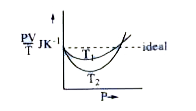(A): Magnitude of most probable velocity of gas molecules is equal to most probable speed of the molecules.
(R): Most probable velocity is most probable speed in the given direction,Solution in Telugu
Both (A) and ( R) are true and (R ) is the correct explanation of (A)
Both (A) and (R ) are true and (R ) is not the correct explanation of (A)
(A) is true but (R ) is false
Both (A) and (R ) are false
The correct Answer is:A
Step by step video, text & image solution for (A): Magnitude of most probable velocity of gas molecules is equal to most probable speed of the molecules. (R): Most probable velocity is most probable speed in the given direction, by Physics experts to help you in doubts & scoring excellent marks in Class 11 exams.
Topper's Solved these Questions
- BOOK - AAKASH SERIESCHAPTER - KINETIC THEORY OF GASESEXERCISE - EXERCISE-2(Kinetic Theory of an ideal gas)25videos
KINETIC THEORY OF GASES
- BOOK - AAKASH SERIESCHAPTER - KINETIC THEORY OF GASESEXERCISE - EXERCISE-3(Kinetic Theory of an ideal gas)4videos
KINETIC THEORY OF GASES
- BOOK - AAKASH SERIESCHAPTER - KINETIC THEORY OF GASESEXERCISE - EXERCISE-IA(Degree of Freedom)35videos
KINETIC THEORY OF GASES
- BOOK - AAKASH SERIESCHAPTER - KINEMATICSEXERCISE - ADDITIONAL PRACTICE EXERCISE (PRACTICE SHEET (ADVANCED)) (Integer Type Questions)12videos
KINEMATICS
- BOOK - AAKASH SERIESCHAPTER - LAWS OF MOTIONEXERCISE - PRACTICE EXERCISE108videos
LAWS OF MOTION
Similar Questions
cylinder of capacity 20 litres is filled with H2 gas. The total average kinetic energy of translatory motion of its molecules is 1.5×105 J. The pressure of hydrogen in the cylinder is
01:48View SolutionGiven is the graph between PV/T and P for 1 gm of oxygen gas at two different temperature T1 and T2 (Given:Density of oxygen=1.429kg/m3).The value of PV/T at the point A and the relation between T1 and T2 and respectively
 02:43View Solution
02:43View SolutionA cylinder rolls without slipping down an inclined plane, the number of degrees of freedom it has, is
03:57View SolutionThree particles start from origin at the same time: one with velocity v1 along positive x - axis, the second along the positive y-axis with a velocity v2 and the third along the line y=x with such a speed that all the three always stay in a straight line, then the velocity of the third particle is √kV1V2(V1+V2).
00:58View SolutionA force of 50 N acts on a body of mass 10 kg at rest. Its velocity after 5 seconds if the same force acts, is
00:47View SolutionThe ratio of most probable speed, average speed and rms speed of gas molecules is………………………………
02:31View SolutionAssertion : The rms velocity and most probable speeds of the molecules in a gas are same.
The Maxwell distribution curve for the speed of the molecules in a gas is symmetrical.04:01View Solutionप्रायितकता वेग (most probable speed) से औसत वेग (average speed) का अनुपात है :
01:02View SolutionGiven the ratio of RMS, average and most probable speeds of gas molecules.
01:15View SolutionThe most probable speed of gas molecules is________.
01:31View SolutionIs the most probable velocity of gas molecule higher or lower than the mean velocity ?
View SolutionThe most probable speed of the molecules in a gas at temperature T_2 is equal to the average speed of the molecules at temperature T_1 Find T_2 //T_1
02:46View SolutionThe most probable velocity of the molecules is given by (m is mass of a molecule)
01:32View SolutionThe most probable speed of O2 molecules at T(K) is
01:21View Solution(A): The root mean square and most probable speeds of the molecules in a gas are the same. (R): The Maxwell distribution for the speed of the molecules in a gas is a symmetrical.
00:58View Solution
